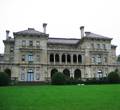
Renaissance Revival (1840s – 1915)
A fascination for the architecture of Renaissance Europe and the villas of Andrea Palladio inspired elegant Renaissance Revival homes.
History:
Renaissance (French for “rebirth”) refers to the artistic, architectural, and literary movement in Europe between the 14th and 16th centuries. The Renaissance Revival style is based on the architecture of 16th-century Renaissance Italy and France, with additional elements borrowed from Ancient Greek and Roman architecture. Renaissance Revival is a general term which encompasses the various Italian Renaissance Revival and French Renaissance Revival styles, including Second Empire.
The Renaissance Revival style was popular during two separate phases. The first phase, or the First Renaissance Revival, was from about 1840 to 1885, and the Second Renaissance Revival, which was characterized by larger and more elaborately decorated buildings, was from 1890 to 1915. Due to the expensive materials required and the elaborate style, Renaissance Revival was best suited for public and commercial buildings, and very grand homes for the wealthy.
Features:
Cube-shaped
Balanced, symmetrical façade
Smooth stone walls, made from finely-cut ashlar, or smooth stucco finish
Low-pitched hip or Mansard roof
Roof topped with balustrade
Wide eaves with large brackets
Horizontal stone banding between floors
Segmental pediments
Ornately-carved stone window trim varying in design at each story
Smaller square windows on top floor
Quoins (large stone blocks at the corners)
“Second” Renaissance Revival Houses are larger and usually feature:
Arched, recessed openings
Full entablatures between floors
Columns
Ground floor made of rusticated stone with beveled edges and deeply-recessed joints
About the Renaissance Revival Style
Next: Second Empire Style